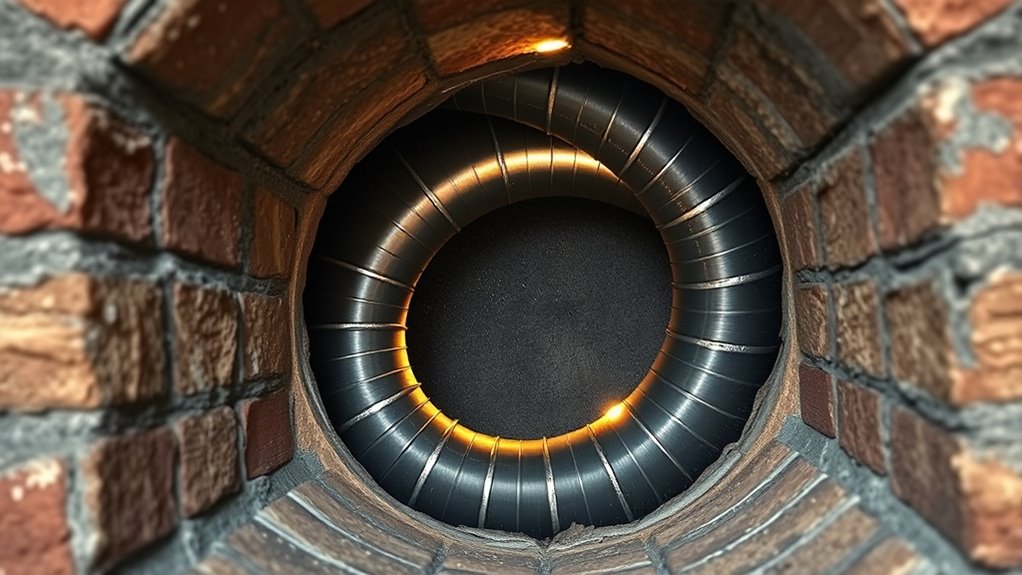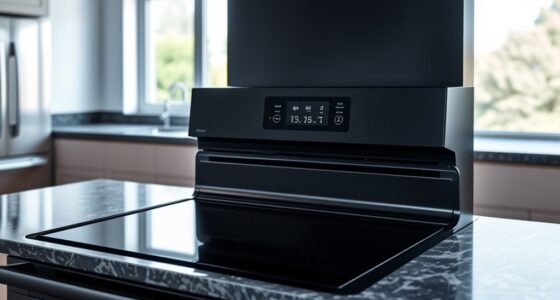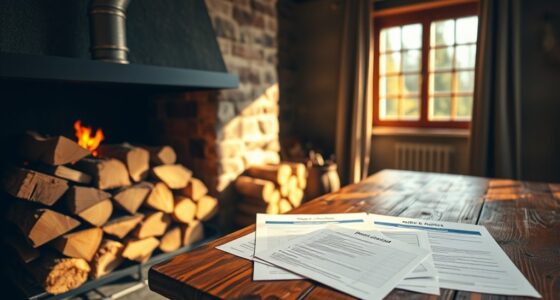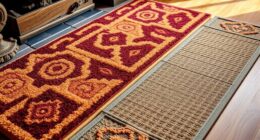To guarantee safety and code compliance, choose the right masonry chimney liner made from trusted materials like stainless steel, clay, or ceramic. Follow manufacturer instructions and local building codes closely during installation, ideally by a professional. Regular inspections and maintenance help prevent hazards like leaks or structural damage. Properly installed and maintained liners protect your home, extend the chimney’s lifespan, and keep your family safe. Discover more about safe practices and standards to keep your chimney in top shape.
Key Takeaways
- Follow local building codes and manufacturer guidelines for proper chimney liner installation.
- Use fireproof materials like stainless steel, clay, or ceramic that meet safety standards.
- Ensure the liner fits securely, is properly anchored, and maintains appropriate clearances.
- Schedule regular inspections and maintenance to identify and address potential safety issues.
- Professional installation by certified experts ensures compliance and safe operation of masonry chimney liners.

Have you ever wondered how to safeguard your masonry chimney and ensure it operates safely? The key lies in understanding the importance of proper chimney liners, especially when it comes to fireproof materials and installation standards. A masonry chimney, while durable, isn’t entirely invulnerable to heat, corrosion, or structural damage. Without a proper liner, the risk of house fires, carbon monoxide leaks, and costly repairs increases markedly. That’s why choosing the right materials and adhering to strict installation standards is essential for your safety and peace of mind.
Fireproof materials are at the core of a reliable chimney liner. These materials, such as stainless steel, clay, or ceramic, are designed to withstand high temperatures and resist corrosion from flue gases. Stainless steel liners are popular due to their durability, ease of installation, and ability to handle different fuel types. Clay tiles, on the other hand, have been used traditionally and offer excellent heat resistance, but they can crack under stress or thermal shock if not installed correctly. Ceramic liners provide even greater heat resistance and longevity but tend to be more expensive. When selecting fireproof materials, it’s vital that you consider the type of fuel you use, the size of your chimney, and the local building codes to guarantee compatibility and safety. Proper material selection is crucial to prevent structural issues and ensure safety.
Fireproof chimney liner materials include stainless steel, clay, and ceramic designed to withstand heat and resist corrosion.
Installation standards play a pivotal role in guaranteeing your chimney liner performs as intended. Proper installation not only maximizes safety but also extends the lifespan of your chimney system. It’s important to follow the manufacturer’s guidelines and local building codes meticulously. This includes ensuring the liner fits snugly within the chimney, is securely anchored, and has appropriate clearances from combustible materials. Installing a chimney liner isn’t a DIY project unless you’re experienced; it’s best to hire certified professionals who know the specific installation standards required for your type of chimney and liner material. Proper venting, sealing, and ensuring correct clearance are all critical points that must be addressed during installation to prevent leaks, blockages, or potential fire hazards. Additionally, integrating proper maintenance practices can greatly enhance the longevity and safety of your chimney system. Regular inspections and professional assessments are essential for maintaining safety and compliance over time. Staying informed about industry standards ensures your setup remains compliant and safe. Furthermore, understanding the local building codes helps ensure your chimney system meets all necessary safety criteria and regulations.
Ultimately, safeguarding your masonry chimney involves more than just installing a liner; it requires selecting the right fireproof materials and adhering strictly to installation standards. Doing this not only helps prevent dangerous situations but also enhances your chimney’s efficiency and longevity. Regular inspections and maintenance further guarantee that your chimney remains safe over time. By paying attention to these details, you can enjoy the cozy warmth of your fireplace or stove with confidence, knowing you’ve taken the necessary steps to keep your home safe.
Frequently Asked Questions
Are Masonry Chimney Liners Required by Local Building Codes?
Yes, building codes usually require masonry chimney liners to guarantee safety and proper venting. You need to choose a liner made from durable materials like stainless steel or clay to withstand high temperatures and prevent damage over time. Check your local building codes to confirm specific requirements, as they can vary. Installing a code-compliant, durable liner helps protect your home and ensures your chimney functions safely.
How Often Should Masonry Chimney Liners Be Inspected or Replaced?
Did you know that most chimney fires start due to soot buildup or liner deterioration? You should have your masonry chimney liner inspected at least once a year as part of regular chimney maintenance. If your liner is over 25 years old or shows cracks, it’s time to contemplate replacing it. Proper maintenance extends the liner’s lifespan and keeps your home safe from potential hazards.
Can I Install a Masonry Chimney Liner Myself?
You can attempt a DIY installation of a masonry chimney liner, but it’s not recommended for chimney safety reasons. Chimney safety is vital, and improper installation can lead to dangerous conditions like leaks or fires. If you’re not experienced, it’s better to hire a professional. They guarantee the liner meets code requirements and is installed correctly, ultimately protecting your home and loved ones from potential hazards.
What Materials Are Best for Masonry Chimney Liners?
You should choose stainless steel or clay tiles for masonry chimney liners, as they offer excellent material durability and withstand high temperatures. Stainless steel liners are flexible, making installation easier with proper methods, while clay tiles require careful handling during installation to prevent cracks. Both options ensure safety and longevity, but stainless steel is often preferred for its durability and ease of installation, especially in DIY projects.
Do Masonry Chimney Liners Affect Fireplace Efficiency?
While it might seem counterintuitive, masonry chimney liners don’t directly boost your fireplace’s efficiency; instead, they protect against fireplace moisture and enhance liner durability. By preventing moisture buildup, liners help maintain proper draft and heat flow, ensuring your fireplace operates smoothly. So, though they don’t increase efficiency outright, they preserve the system’s integrity, keeping your fireplace working safely and effectively for years to come.
Conclusion
To guarantee your masonry chimney liner is both safe and up to code, don’t cut corners. Regular inspections and proper installation are key—otherwise, you could be inviting trouble in through the back door. Remember, a well-maintained chimney isn’t just about safety; it’s about peace of mind. When you follow the rules and stay vigilant, you’re playing it smart and keeping your home and loved ones out of harm’s way. It’s better to be safe than sorry.










